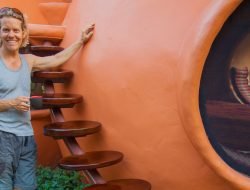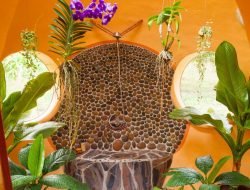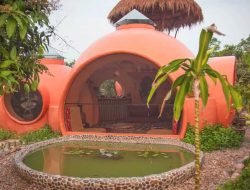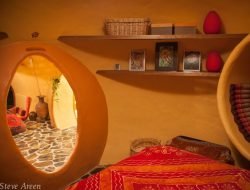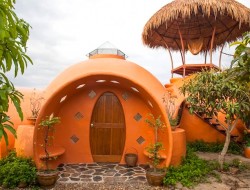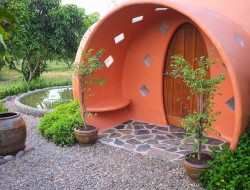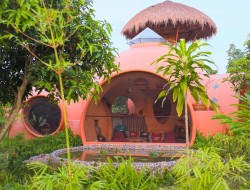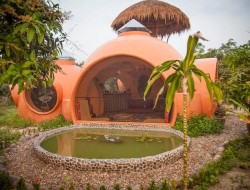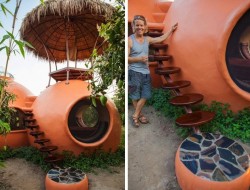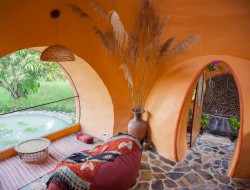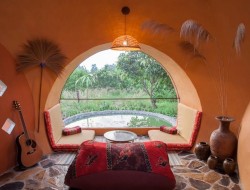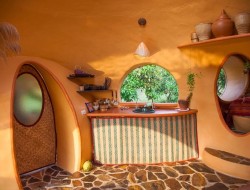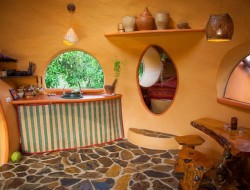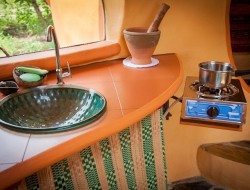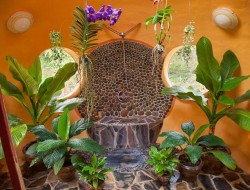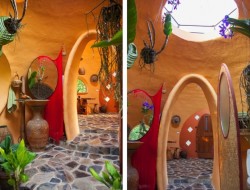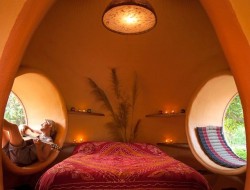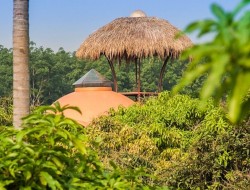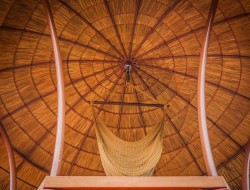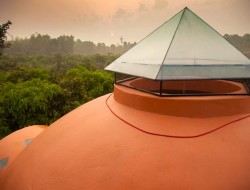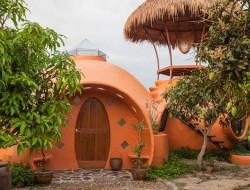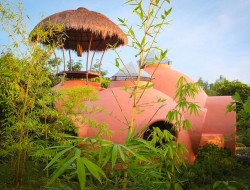Last Updated on September 10, 2024 by teamobn
A mango farm somewhere in North-East Thailand – Steve Areens…
Built area: 500 sq. ft. (46 m2) + hammock 😉
Steve Areen went from flight steward to owner-builder of this unique home. He completed the main structural work to habitable standard in just six weeks with one full time helper and one casual hand when needed. He used a technique developed by a friend to give him a perfect sphere. He then completed the detail work himself over the next few months using only locally available materials – most of them free. The result is this beautiful home completed for just $9,000.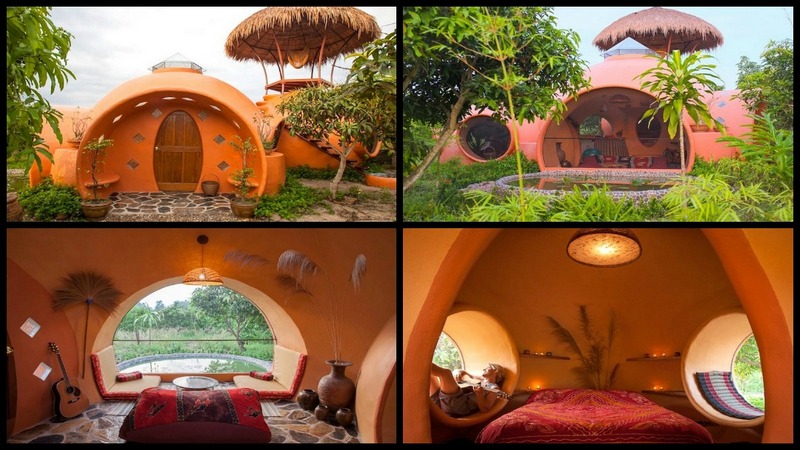
Click on any image to start lightbox display. Use your Esc key to close the lightbox. You can also view the images as a slideshow if you prefer 😎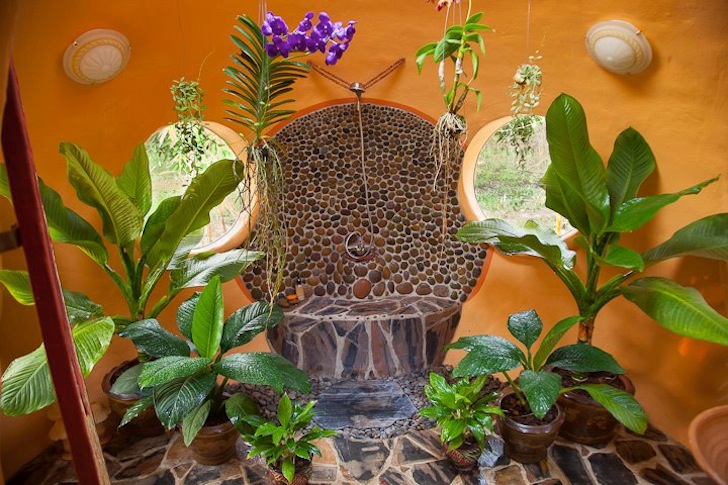
Amazing? Watch the video and then view the album by clicking on any image to start lightbox display. Use your Esc key to close the lightbox.
Eco-Friendly Aspects of Dome Houses
Dome houses, exemplified by unique projects like the Thailand Dome House, are becoming increasingly popular due to their eco-friendly attributes. These structures not only offer a distinctive aesthetic but also provide a sustainable solution to modern housing challenges. The Thailand Dome House is a prime example of how dome architecture can merge functionality with environmental consciousness, offering insights into the benefits of such designs.
Energy Efficiency
The Thailand Dome House showcases exceptional energy efficiency, a hallmark of dome-shaped constructions. The natural aerodynamics of the dome shape allows for efficient air circulation, reducing the need for extensive heating and cooling systems. This design minimizes energy consumption, making the Thailand Dome House not only a comfortable living space but also a friend to the environment. Furthermore, the thermal insulation properties of the materials used in domes help maintain a consistent internal temperature, cutting down on energy costs.
Use of Sustainable Materials
Another significant eco-friendly aspect of the Thailand Dome House is its reliance on locally sourced, sustainable materials. By utilizing materials such as local clay, bamboo, and other renewable resources, the impact on the environment is significantly reduced. These materials are not only abundant and cost-effective but also biodegradable, leaving minimal environmental footprints. This approach not only supports local economies but also encourages a sustainable cycle of resource use and reuse.
Reduced Construction Waste
The construction process of the Thailand Dome House was designed to produce minimal waste. Dome structures typically require fewer materials than traditional buildings, resulting in less excess and waste production. This efficiency is crucial in promoting environmental sustainability and reducing the overall construction impact on the surrounding landscape. The precise use of materials in projects like the Thailand Dome House demonstrates a commitment to eco-conscious construction practices.
Water Conservation
Including water-conserving elements into dome buildings will improve their environmental friendliness even more. To cut water consumption, the Thailand Dome House, for instance, might employ greywater recycling and rainwater collecting technologies. These systems not only help to reduce the demand on nearby water resources but also guarantee that the house minimizes its environmental impact, so guiding sustainable living patterns.
Longevity and Durability
Particularly well-known for their longevity are dome houses like Thailand Dome House. They also withstand typhoons and earthquakes, among natural disasters. Longer lifetime and less frequent need for repairs or rebuilding resulting from this resilience help to lower demand for raw resources and energy over time. The Thailand Dome House is a prime example of how investing in sustainable building methods results in a better future. Durable building methods
The Thailand Dome House is more than just a house; it’s evidence of the creative possibilities for environmentally friendly living via design. Its environmentally friendly aspects highlight the need of energy efficiency, sustainable material use, waste reduction, water conservation, and durability in building methods. Dome houses might become a major component in the architecture of a more sustainable world as more people and communities realize these advantages.
Cost Analysis and Budgeting
Constructing a dome house, like the Thailand Dome House, offers a unique opportunity to build an environmentally friendly and aesthetically pleasing home at a potentially lower cost than traditional structures. The Thailand Dome House, built for just $9,000, serves as an exemplary model of budget-conscious construction without compromising on quality or sustainability.
This section delves into how the costs were managed effectively during the project and offers insights for those considering similar endeavors.
Initial Budget Planning
Before breaking ground on the Thailand Dome House, careful planning was essential to establish a clear and manageable budget. Detailed cost estimates were prepared, considering everything from materials to labor. By setting a realistic budget from the outset, Steve Areen was able to avoid unexpected expenses and ensure that the project stayed financially feasible. Key to this was his choice of location and materials, which significantly influenced the overall expenditure.
Material Costs
A significant portion of the savings for the Thailand Dome House came from the strategic selection of materials. Most of the construction materials were locally sourced, some of which were provided at no cost. Materials like clay and gravel, common in Northeast Thailand, were used extensively, reducing the need to purchase or transport expensive or non-local resources. This not only kept the costs low but also supported the local economy and reduced the carbon footprint associated with transportation.
Labor Costs
Labor costs can be one of the most substantial expenses in any construction project. However, the Thailand Dome House managed to minimize these costs by using a small team. Steve employed one full-time helper and occasionally a casual hand when needed. This approach of using minimal skilled labor, supplemented by his own efforts, drastically cut down on the costs. It also allowed for a more personal involvement in the building process, ensuring that every aspect met his standards without the need for extensive external labor.
Tools and Techniques
The construction of the Thailand Dome House relied on simple tools and a unique construction technique developed by a friend to create perfect spheres. By using innovative yet straightforward techniques and tools, the need for expensive machinery or highly specialized skills was eliminated. This significantly reduced the project’s overall expenses and demonstrated that innovative thinking and resourcefulness are just as valuable as financial resources in home-building.
Unexpected Expenses
Despite careful planning, the Thailand Dome House project, like any construction endeavor, faced potential unexpected expenses. To manage these, a contingency fund was part of the initial budget. This proactive measure ensured that small unforeseen costs did not derail the overall project. It highlights the importance of planning for the unexpected in budget management, particularly in unconventional projects like dome house construction.
The financial strategy employed in building the Thailand Dome House highlights the potential for affordable housing solutions through innovative design and resource management. By keeping material and labor costs low, utilizing local resources, and planning for unexpected expenses, the project showcases how cost-effective and sustainable living spaces can be created with careful budgeting and creative construction techniques. As dome houses gain popularity, these budgeting strategies provide valuable lessons for future builders.
Cultural Significance and Inspiration of the Thailand Dome House
The Thailand Dome House, built by Steve Areen on a mango farm in Northeast Thailand, stands as a vibrant testament to the blend of creativity, environmental consciousness, and cultural homage. This unique structure not only serves as a home but also as a symbol of how traditional Thai architectural elements can be woven into modern, sustainable living spaces.
This section explores the cultural inspirations behind the design of the Thailand Dome House and its significance within the local and broader architectural context.
Incorporation of Thai Architectural Elements
The design of the Thailand Dome House incorporates several elements typical of traditional Thai architecture, adapting them to a modern structure. The use of natural, locally sourced materials, such as clay and bamboo, reflects the Thai principle of living harmoniously with nature.
Additionally, the house’s round shape mimics the fluid, organic forms often seen in Thai temples and homes, which are designed to encourage airflow and natural cooling—an essential feature in Thailand’s tropical climate. This architectural choice not only pays respect to local customs but also optimizes the home’s environmental efficiency.
Symbolism and Aesthetics
The Thailand Dome House goes beyond functional living; it embodies a piece of art influenced by Thai culture. The dome itself can be seen as a symbol of wholeness and unity, echoing the Buddhist philosophy of completeness and balance that is central to Thai culture. The vibrant colors and textures used throughout the home also reflect Thailand’s rich tapestry of art and craftsmanship, turning the house into a living canvas that showcases the beauty of Thai artistic traditions.
Community and Collaboration
Building the Thailand Dome House was a collaborative effort that involved local workers and materials, reinforcing the community-centric approach of traditional Thai building projects. In many Thai communities, the construction of a home is a communal activity that strengthens social ties and ensures mutual support.
By engaging local helpers and using materials that could be sourced from the immediate environment, Steve Areen tapped into this communal spirit, integrating his project within the local ecosystem both socially and environmentally.
Impact on Local and Global Architecture
The Thailand Dome House serves as an inspiration not only to the local community but also to architects and builders worldwide. It stands as a case study in how traditional and modern techniques can merge to create sustainable, cost-effective, and culturally resonant living spaces.
The project highlights the potential for global architectural practices to learn from and incorporate traditional Thai building principles, such as adaptability to the local environment and community involvement in construction processes.
The Thailand Dome House is not just a structure; it’s a profound expression of cultural respect and environmental responsibility. Its design and construction process reflect a deep appreciation for Thai heritage and craftsmanship, offering a blueprint for integrating traditional architectural principles into new, sustainable forms of building. By embracing local materials and practices, the Thailand Dome House stands as a beacon of cultural continuity and innovation, inspiring builders both in Thailand and around the globe.
You’re also sure to enjoy this Tiny Cabin in Maine…

